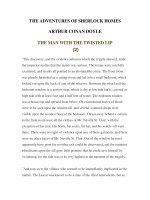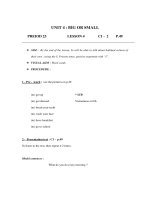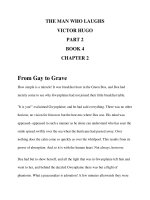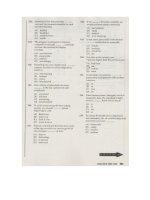4 6 2 the carlisle indian school (nonfiction)
Bạn đang xem bản rút gọn của tài liệu. Xem và tải ngay bản đầy đủ của tài liệu tại đây (8.26 MB, 6 trang )
Reader
The Carlisle
Indian School
by Amanda Turner
Genre
Nonfiction
Build Background
Access Content
Extend Language
• Native
American
Education
• Lakota Sioux
• Families
• Captions
• Definitions
• Historical
Photographs
• Maps
• Word Origins
Scott Foresman Reading Street 4.6.2
ì<(sk$m)=becbdc< +^-Ä-U-Ä-U
ISBN 0-328-14213-1
Talk About It
1. What did Captain Pratt tell Spotted Tail to get him
to send the Sioux children to Carlisle?
2. The Lakota Sioux children were among the first
students at the Carlisle Indian School. Is this a
statement of fact or an opinion?
The Carlisle
Indian School
Write About It
by Amanda Turner
3. Pretend you are a student at the Carlisle School in
the year 1900. On a separate sheet of paper, write
a letter home to your family.
Extend Language
People like Captain Pratt wanted Native Americans
to forget their home languages. But English includes
hundreds of words that come from Native American
languages. For example, the word raccoon probably
comes from the Algonquian word arocoun. Use
dictionaries to find out about the origins of these words:
moose
squash
kayak
Photographs
Every effort has been made to secure permission and provide appropriate credit for photographic material. The
publisher deeply regrets any omission and pledges to correct errors called to its attention in subsequent editions.
Cover ©Corbis; 1 ©Cumberland County Historical Society; 2 (TL, TR) ©Digital Wisdom,
Inc.; 3 ©Corbis; 4 ©Corbis; 5 ©Hulton Archive Photos/Getty Images; 6 (TL, TR)
©Cumberland County Historical Society; 7 ©Corbis; 8 ©Corbis.
ISBN: 0-328-14213-1
Copyright © Pearson Education, Inc.
All Rights Reserved. Printed in the United States of America.
This publication is protected by Copyright, and permission should be obtained from
the publisher prior to any prohibited reproduction, storage in a retrieval system,
or transmission in any form by any means, electronic, mechanical, photocopying,
recording, or likewise. For information regarding permission(s), write to: Permissions
Department, Scott Foresman, 1900 East Lake Avenue, Glenview, Illinois 60025.
Editorial Offices: Glenview, Illinois • Parsippany, New Jersey • New York, New York
Sales
Massachusetts
• Duluth,
1234
5 6 7Offices:
8 9 10 Needham,
V0G1 14 13
12 11 10 09 08
07 06 05Georgia • Glenview, Illinois
Coppell, Texas • Sacramento, California • Mesa, Arizona
1850
1890
These two maps show how much land Native Americans
lost between 1850 and 1890. Native American land is
shaded in purple.
Captain Richard Pratt
Captain Pratt’s Idea
From Land to Reservations
The western United States was home to Native
Americans for thousands of years. In the mid1800s, many European American settlers moved
to the West, and Native Americans began to
lose their land to the settlers. The United States
army fought Native Americans. By 1890, Native
Americans in the West had lost most of their land.
As Native Americans lost their land, they were
moved to reservations. The government often
forced Native American leaders to sign treaties
that gave up their land. Some Native Americans
also agreed to move to reservations.
forced: made someone do something by force
treaties: formal agreements
2
The government used reservations as one
way of controlling Native Americans. But
some leaders in the United States government
worried that Native Americans would still try
to keep their land by fighting white settlers.
They thought that the best way to make Native
Americans stop fighting was to teach them to
live like white people.
Captain Richard Pratt of the United States
Army felt this way. He thought that Native
American children should be sent to boarding
schools to live away from home. At these schools,
Native American children would learn to speak
English and to dress and act like white people.
The children would be kept away from their
homes for a long time to change their attitudes.
attitudes: ways of thinking or feeling
3
Captain Pratt’s
Idea Becomes
Reality
In 1879,
Captain Pratt
received
permission from
the government
to turn an old
army post into a
boarding school.
Chief Spotted Tail visited
The army post
Carlisle in 1880.
was in Carlisle,
Pennsylvania.
The school would be called the Carlisle Indian
Industrial School.
Now Captain Pratt needed students for his
school. He visited the Lakota Sioux on their
reservation in South Dakota.
Captain Pratt called the chiefs and warriors
together. He told them that it would be good
for their children to learn English. He told
them about the school in Carlisle where they
could learn to live like white people. The
greatest chief Spotted Tail did not trust white
men. He felt they had stolen the land from his
people. He did not want the children to learn
to lie and steal.
4
Native American children learned many things from their
families at home.
Captain Pratt told Spotted Tail that if he had
known how to read, write, and speak English, he
might have been able to save the lands for his
people.
The chiefs sent Captain Pratt outside while
they discussed his boarding school idea. No one
wanted to send the children away. But they
wanted a better life for their children. Finally the
chiefs agreed to send the children away.
The Lakota Sioux children were among the
first students at the Carlisle Indian School.
Between 1879 and 1918, the school enrolled
students from nearly every Native American tribe
in the United States.
5
Three Native American boys, before (left) and after
(right) their first days at Carlisle
First Days at School
The first days at Carlisle Indian School were
painful for the children. They missed their
families and homes very much. There were many
difficult changes that the children had to make.
The children had to wear clothes and shoes
that felt strange and uncomfortable. The boys
suffered when their long hair was cut off. Since
Native American men had long hair, the boys felt
humiliated to have short hair.
Teachers also gave the children new names in
English. Since the children did not know English,
at first it was difficult for them to pronounce
the names. The children also had to learn new
customs for eating and other basic routines.
Everything in their lives changed.
painful: full of suffering, difficult
Girls working at the Carlisle School
Daily School Routines
The United States Army was in charge of the
Carlisle School. Life for the children was very
much like military life. The children slept in
dormitories—large buildings with many rooms
for sleeping. They dressed like soldiers. They
marched to the dining room and to class.
The children did most of the hard work
around the school. The girls washed and ironed
clothes, scrubbed floors, cooked, and washed
dishes. The boys worked outdoors, plowing,
planting, harvesting crops, and taking care of the
farm animals. They also learned to be carpenters
and bricklayers. As the school grew, they built
the new dormitories and classrooms.
humiliated: ashamed
6
7
Talk About It
1. What did Captain Pratt tell Spotted Tail to get him
to send the Sioux children to Carlisle?
2. The Lakota Sioux children were among the first
students at the Carlisle Indian School. Is this a
statement of fact or an opinion?
Write About It
3. Pretend you are a student at the Carlisle School in
the year 1900. On a separate sheet of paper, write
a letter home to your family.
Extend Language
Life at Carlisle was lonely and difficult. Many
children never adjusted to the new customs.
Some children died from illness and homesickness.
Most children were not allowed to return to their
homes for years.
Later in life, graduates of the Carlisle School
had different feelings about their experiences.
Some of them kept their English names,
continued to wear clothes like the styles they
wore at the school, and lived their lives away
from the reservations. Others returned to their
homelands and followed their traditional ways
of life.
homesickness: missing their home and family
8
People like Captain Pratt wanted Native Americans
to forget their home languages. But English includes
hundreds of words that come from Native American
languages. For example, the word raccoon probably
comes from the Algonquian word arocoun. Use
dictionaries to find out about the origins of these words:
moose
squash
kayak
Photographs
Every effort has been made to secure permission and provide appropriate credit for photographic material. The
publisher deeply regrets any omission and pledges to correct errors called to its attention in subsequent editions.
Cover ©Corbis; 1 ©Cumberland County Historical Society; 2 (TL, TR) ©Digital Wisdom,
Inc.; 3 ©Corbis; 4 ©Corbis; 5 ©Hulton Archive Photos/Getty Images; 6 (TL, TR)
©Cumberland County Historical Society; 7 ©Corbis; 8 ©Corbis.
ISBN: 0-328-14213-1
Copyright © Pearson Education, Inc.
All Rights Reserved. Printed in the United States of America.
This publication is protected by Copyright, and permission should be obtained from
the publisher prior to any prohibited reproduction, storage in a retrieval system,
or transmission in any form by any means, electronic, mechanical, photocopying,
recording, or likewise. For information regarding permission(s), write to: Permissions
Department, Scott Foresman, 1900 East Lake Avenue, Glenview, Illinois 60025.
1 2 3 4 5 6 7 8 9 10 V0G1 14 13 12 11 10 09 08 07 06 05









